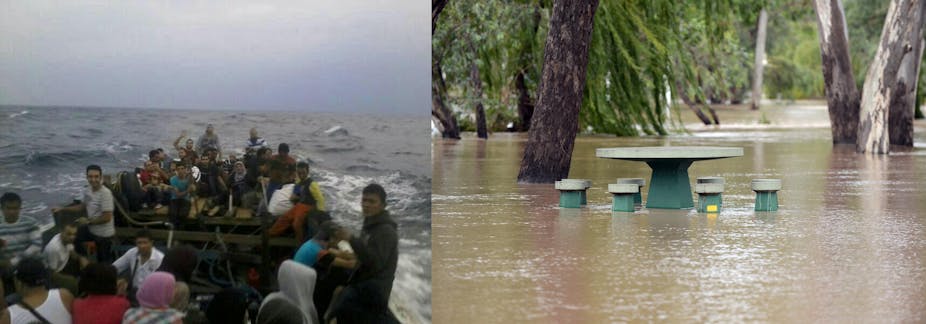As anyone who has seen immigration minister Scott Morrison’s recent military-style press conferences knows, the Coalition has declared asylum seeker boats arriving in Australia are a “national emergency”. What makes it so? And why haven’t other apparent emergencies earned the tag?
According to the Coalition’s policy statement on border security, the asylum seeker crisis cannot be solved by just bureaucratic management – it needs the “discipline and focus of a targeted military operation”.
Between 2008 and mid-2013, 744 boats carrying 44,317 asylum seekers have arrived. Of these, 862 people died attempting to reach the Australian mainland.
Does calling it a crisis make it one?
The Coalition’s branding of the boat people issue as a “national emergency” surprised many. If the 4940 boat people arrivals in 2010-2011 constitutes a “national emergency,” then do the 6316 asylum seekers that arrived by plane in the same period receive this label?
Should the 1303 citizens who died on Australian roads in 2012 be regarded in the same vein?
What exactly constitutes a “national emergency?”
Put simply, a national emergency exists only when people believe it exists.
In Australia, the Attorney General’s Department is responsible for emergency management. However, the department currently does not define a “national emergency”. This means politicians and interest groups are able to use the term at will.
Issues that have attracted the national emergency label are wildly diverse: combating the child sexual abuse and neglect in Northern Territory Aboriginal communities (called the Northern Territory National Emergency Response Intervention), perceived decline in local production of food, housing shortages, damage in the Murray-Darling Basin and the lack of increase in national productivity.
While all of these issues are recognised as crises that require focused attention, only a few are accepted as actual national emergencies.
If it feels like an emergency, maybe it’s an emergency
There are two factors needed for a crisis to really earn the label of national emergency. First, the actual or potential impact of the crisis; second, peoples’ interpretations of its importance.
The impact of the crisis, either actual or potential, on Australians is obviously critical. The greater the impact’s size and reach, the more likely a crisis is to be deemed an emergency.
Acute crises, delivered over a short period, are more likely to be considered an emergency than those that unfold over months and years. This is because acute crises do not give people time to get used to and adjust to the impact.
The impact does not have to be physical to be considered an emergency. Impacts on values, beliefs and interests can be just as confronting as physical damage.
A national emergency is also determined by how the event is perceived by people. Cognitive limitations play a large part in the perception of threats.
People tend to fear more when they are less informed about an issue, ultimately over-estimating the threat. In situations where the threat is invisible, such as cyber warfare or health epidemics like SARS, the public become more fearful than they would in the face of a physical, quantitative threat. Moreover, people fear more threats which they cannot control. In the case of asylum seeking boats, as Australians hear about but do not experience the threat, it is easy for the cognitive biases to imagine the scenario where asylum seekers overwhelm Australia.
Treat it like an emergency, and it becomes an emergency
Governments which claim an event is a national emergency actively seek to shape public opinion. They repeatedly detail the threat, over-emphasize the consequences, and most importantly, securitize the issue.
Securitization is an international relations concept in which an event or object is labeled as a security issue. Extraordinary measures must be taken in the name of security. Or as Ole Wæver, the coiner of the term, puts it, “It is by labelling something a security issue that it becomes one.”
Securitizing an issue elevates its importance above other national priorities, creating a link in peoples’ minds between the issue and the potential for devastation if left unchecked. It then allows policy makers to address the issue outside of the normal realm of politics and deal with it using emergency methods.
What about climate change?
Climate change is undoubtedly a serious issue. The most recent IPCC report places it beyond doubt that climate change is real. It has the potential to bring extreme weather, affect Australia’s tourism industry, make certain islands uninhabitable, and result in increased migration.
But despite the enormous potential harm climate change poses, it is not perceived as a national emergency. And based on the discussion above, it is unlikely that climate change will be considered one in the near future.
Why? The impacts are slowly unfolding rather that developing rapidly. The impacts are global, so the pain is shared not localised. And people think they can adapt, so they still feel like they have control.
A well recognised cogitative limitation in disaster management is that peoples’ inaccurate perception of a risk does not evaporate in the presence of rational evidence. On the contrary, if the new evidence challenges existing beliefs, it is often dismissed as unreliable, erroneously or unrepresentative. This means that getting people to believe that climate change is worthy of the national emergency label will be a long and difficult process.
This article was co-authored by Blair Morris, a research assistant for Athol Yates.

